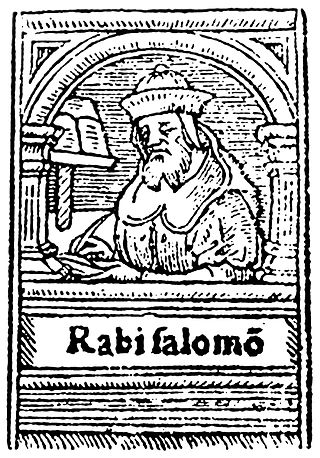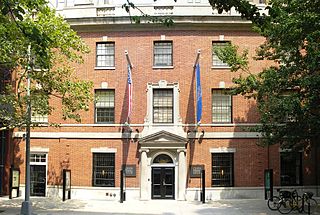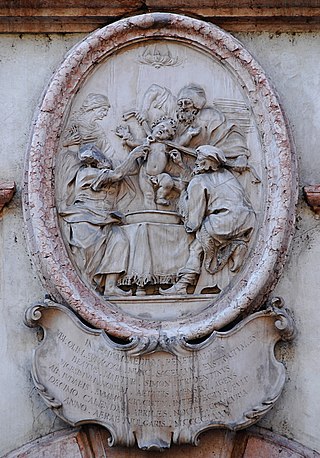
Blood libel or ritual murder libel is an antisemitic canard which falsely accuses Jews of murdering Christians in order to use their blood in the performance of religious rituals. Echoing very old myths of secret cultic practices in many prehistoric societies, the claim, as it is leveled against Jews, was rarely attested to in antiquity. According to Tertullian, it originally emerged in late antiquity as an accusation made against members of the early Christian community of the Roman Empire. Once this accusation had been dismissed, it was revived a millennium later as a Christian slander against Jews in the medieval period. The first examples of medieval blood libel emerged in England in the mid 1100s before spreading into other parts of Europe, especially France and Germany. This libel, alongside those of well poisoning and host desecration, became a major theme of the persecution of Jews in Europe from that period down to modern times.

Shlomo Yitzchaki, commonly known by the acronym Rashi, was a French rabbi who authored comprehensive commentaries on the Talmud and Hebrew Bible.

Simon of Trent, also known as Simeon (1472–1475), was a young boy from the city of Trent, in the Prince-Bishopric of Trent, whose disappearance and death was blamed on the leaders of the city's Jewish community, based on the confessions of Jews obtained under judicial torture.

Book collecting is the collecting of books, including seeking, locating, acquiring, organizing, cataloging, displaying, storing, and maintaining whatever books are of interest to a given collector. The love of books is bibliophilia, and someone who loves to read, admire, and a person who collects books is often called a bibliophile but can also be known as an bibliolater, meaning being overly devoted to books, or a bookman which is another term for a person who has a love of books.

The Simon Wiesenthal Center (SWC) is a Jewish human rights organization established in 1977 by Rabbi Marvin Hier. The center is known for Holocaust research and remembrance, hunting Nazi war criminals, combating anti-Semitism, tolerance education, defending Israel, and its Museum of Tolerance.

The Black Book of Soviet Jewry or simply The Black Book, also known as The Complete Black Book of Russian Jewry, is a 500-page document compiled for publication by Ilya Ehrenburg and Vasily Grossman originally in late 1944 in the Russian language. It was a result of the collaborative effort by the Jewish Anti-Fascist Committee (JAC) and members of the American Jewish community to document the anti-Jewish crimes of the Holocaust and the participation of Jews in the resistance movement against the Nazis during World War II. The 1991 Kyiv edition of The Black Book was subtitled The Ruthless Murder of Jews by German-Fascist Invaders Throughout the Temporarily-Occupied Regions of the Soviet Union and in the German Nazi Death Camps established on occupied Polish soil during the War 1941–1945.

Georg Konrad Morgen was an SS judge and lawyer who investigated crimes committed in Nazi concentration camps. He rose to the rank of SS-Sturmbannführer (major). After the war, Morgen served as witness at several anti-Nazi trials and continued his legal career in Frankfurt.

The Yeshiva University Museum is a teaching museum and the cultural arm of Yeshiva University. Along with the American Jewish Historical Society, the American Sephardi Federation, the Leo Baeck Institute, New York, and the YIVO Institute for Jewish Research, it is a member organization of the Center for Jewish History, a Smithsonian Institution affiliate located in the Chelsea neighborhood of Manhattan.

Chachmei Lublin Yeshiva was a Jewish educational institution (yeshiva) that operated in the city of Lublin, Poland from 1930 to 1939. At the time, it was one of the largest in the world.
Antisemitism in the history of the Jews in the Middle Ages became increasingly prevalent in the Late Middle Ages. Early instances of pogroms against Jews are recorded in the context of the First Crusade. Expulsions of Jews from cities and instances of blood libel became increasingly common from the 13th to the 15th century. This trend only peaked after the end of the medieval period, and it only subsided with Jewish emancipation in the late 18th and 19th centuries.
Ariel Toaff is an Italian-Jewish historian. He is a professor of Medieval and Renaissance History at Bar-Ilan University in Israel, whose work has focused on Jews and their history in Italy.
Passovers of Blood: The Jews of Europe and Ritual Murders is a 2007 book by Israeli historian Ariel Toaff. The book analyses a notorious medieval trial regarding the ritual murder of a child by Jews for the purposes of Passover. Because the book lent credence to one of the ritual murders, it sparked intense controversy including calls for him to resign from or be fired from his professorship; the questioning of his research, historical method(s), and motives as they relate to his writing of the book; threats to his life; and demands that he be prosecuted.

Palazzo Salvadori is a palazzo in Trento, northern Italy, one of the first examples of Renaissance civil architecture in the city, and a symbol of antisemitism.

Erich Kulka was a Czech-Israeli writer, historian and journalist who survived the Holocaust. After World War II, he made it his life's mission to research the Holocaust and publicize facts about it.
Don Vincente, also known as Don Vicente and Fray Vicents, is a fictional character whose story was first published as an anonymous article in the French newspaper La Gazette des Tribunaux, in 1836. The legend was subsequently cited and reproduced as a true story in France and other countries through the 19th and early 20th centuries, while remaining virtually unknown in Spain. No historical evidence of Don Vincente or the criminal process against him has ever been found.

Johannes Hinderbach was Prince-Bishop of Trent from 12 May 1466 until his death. He was by birth a member of the Austrian nobility. Prior to his appointment as Bishop, he served as an advisor to the court of Fredrick III.

Francis Joseph Hogan was an American lawyer who co-founded the firm Hogan & Hartson in 1904 and served as president of the American Bar Association (ABA) from 1938 to 1939. He represented several high-profile clients, including President Warren G. Harding, oil tycoon Edward L. Doheny, and banker Andrew Mellon. As ABA president he created the association's Committee on the Bill of Rights and supported the controversial Walter-Logan bill.
Ronnie Po-Chia Hsia is an American historian and the Edwin Erle Sparks Professor at Pennsylvania State University, where he teaches history and religious studies. His research interests are Catholic Renewal, anti-Semitism and Protestant Reformation.
Battista dei Giudici (1428/29–1484), Latinized Baptista de Iudicibus de Finario, was an Italian Dominican who served as bishop of Ventimiglia, archbishop of Amalfi and archbishop of Patras.

Raffaele Zovenzoni was an Italian humanist and writer.














